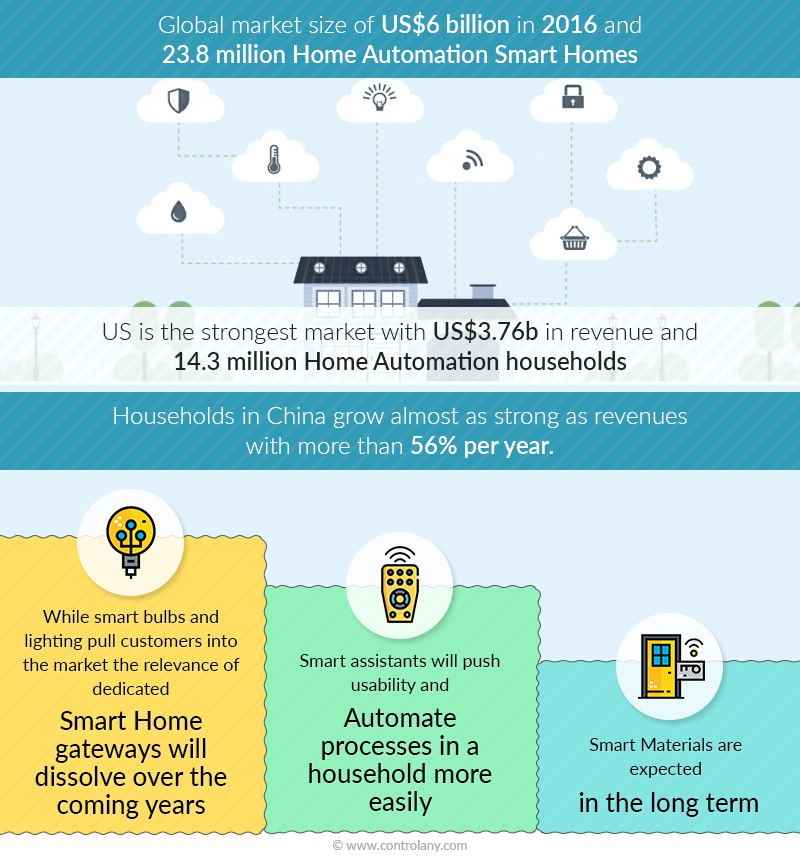

Whether it is turning off lamp or controlling window shares, what if all devices could communicate, send you information, and take your commands according to your preferences. It’s no longer a figment of imagination; it’s the Internet of Things (IoT), and it’s a key component of home automation and smart homes.
Internet of Things is not just connecting smartphones and desktops. It is connecting just about every device. Right from speakers, thermostats, cameras, windows, window blinds, appliances, cooking utensils, entertainment system, IoT aims at connecting everything. According to Statista, revenue in the “Home Automation” segment amounts to US$4,908m in 2017. The global smart home market is forecast to reach a value of more than 40 billion U.S. dollars by 2020.
The smart home presents a whole new world of opportunities and the system enabling smart homes is called home automation. Energy efficiency and entertainment will be important features that smart home product developers are focusing on. As more and more devices continue to transform our lives, we are now gearing for the next big wave of the Internet, called the Internet of Everything (IoE).
 Statistics Courtesy: Statista.com
Statistics Courtesy: Statista.com
Whether your windows cover entire wall, are curved, require privacy, security, motorized window treatments are gaining in popularity, as manufacturers build their product portfolios with different shading solutions. Several solutions can be easily integrated into a complete home control system.
It now the time for smart kitchen as major appliance manufacturers have jumped on the smart appliances bandwagon. Right from Wi-Fi ovens to smart refrigerators, smart kitchen are now making the process of managing food and dietary requirements easy and seamless. Many smart refrigerators have features including food tracking, recipe recommendations, family schedule management, as well as post reminders.
Getting real-time feedback about the energy consumption of individual household appliances. This is a growing trend in smart home about monitoring home electricity unit consumption to create awareness among family. Energy sensors in combination with algorithms can alert about usage of each and every family member from different applications or devices in rooms and send this information to a mobile application.
Dedicated touch panel are making a comeback as control dashboard to monitor and manage smart devices. Touch panels are designed to do display the status of lights, thermostats, and other home equipment, and launch commands to these devices. The touchpanels providing around 12-inch display, full-color screens—enough real estate to provide homeowners with lots of information at a single glance.
Voice activated is on a rise in home automation. The latest feature in voice activation allows different people in the house to set home security with voice commands. Voice activation has several features – the home automation system can sync with different people, who can arm and disarm the system as long as they are recognizable by the system. This system also allows people to control lights with their voice as long as they are authorized and recognized by the system.
Seamless integration of home security system with home automation and cloud technology can enhance security. Cloud can store as well as send videos and pictures to different locations to give an idea of what is happening at precise location during the given time period. Its effective integration with home automation can be critical to home security. Lights and motion sensors can keep house safe from intruders. Cloud integration can set triggers or send live feeds to your mobile when a particular set pattern is not followed
Home automation is also about leading a hassle free and healthy life. Sensors that monitor the quality of air in your house CO2 (carbon dioxide) and increased humidity levels will gain prominence. Going step further sensors can trigger alarm that can help remove bad air from the home to introduce clean, healthy air.
Artificial intelligence is changing the world of home automation to improve user experience. For instance, smart bulbs can understand user behavior and automatically turn lights on or off as per schedule. These bulbs turn lights if you have a visitor at home.
Conclusion
The coming years will see changes in the world of smart home technology and home automation. These changes will be aimed at improving energy consumption/efficiency at your home, ultimately helping you lead healthy lives.
Sign up for our latest blog posts and we’ll keep you updated. Oh, and we don’t spam.